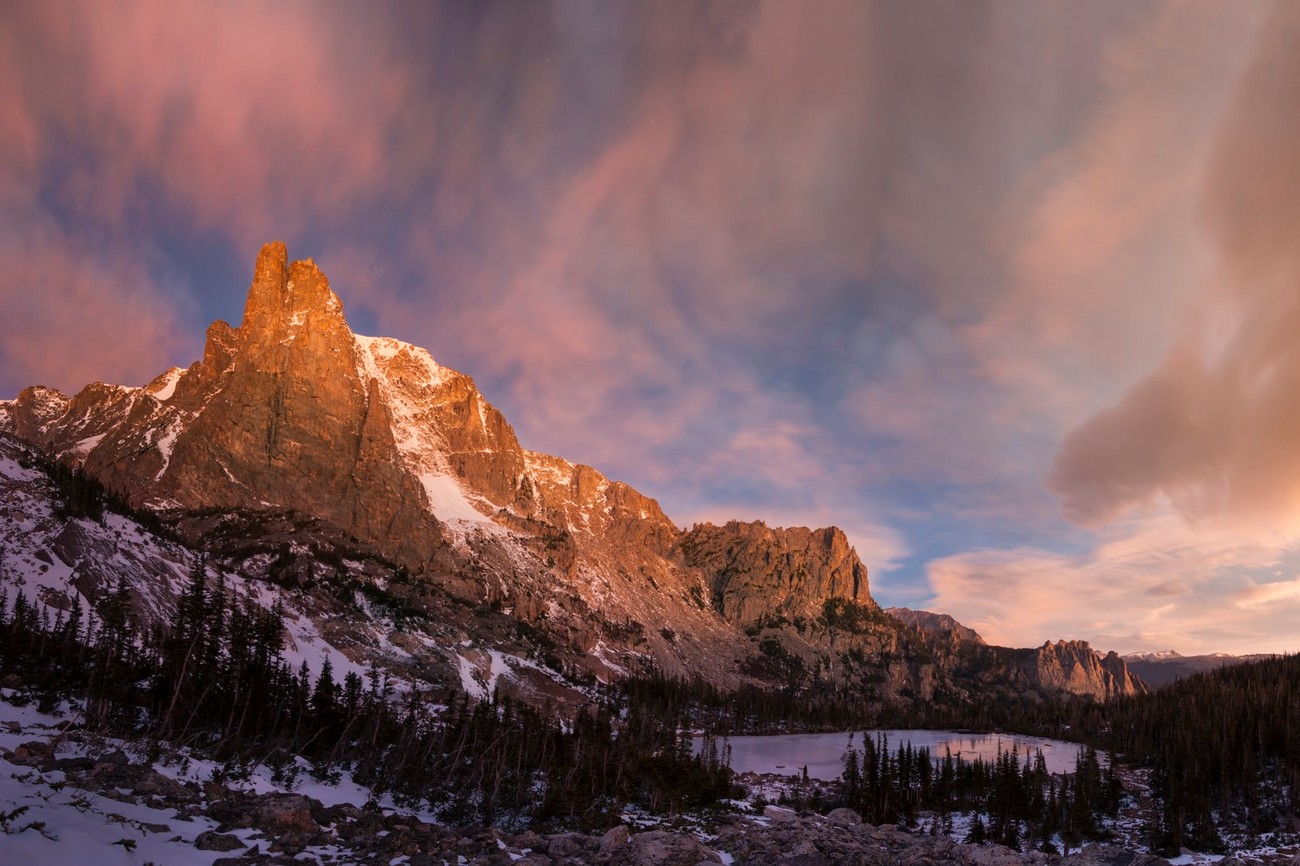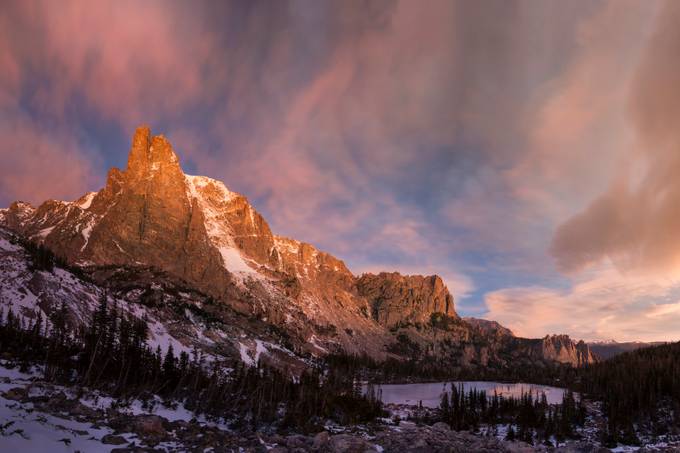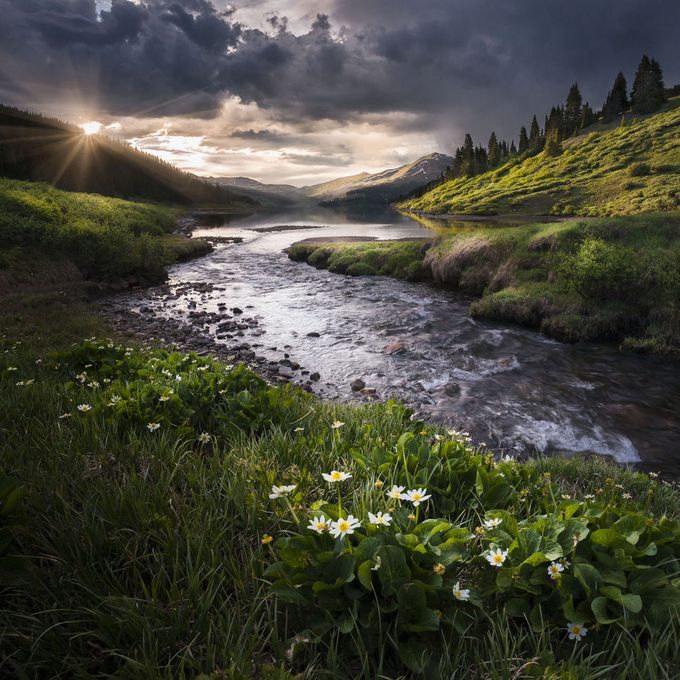If you are passionate and love something, it will show. By looking at Michael’s photos you can clearly see the love he has for Mother Earth. Michael, also known as Medicine Walk Photographer (MedicineWalkPhotographer), is a self-taught hobby photographer who traded his motorcycle for his first camera back in 1976. The love, dedication and long hours he put on creating an image is for the viewer to get the equivalent feeling Michael had when he shot the photo. He wants the viewer to feel the same wonderful sensation he felt when he was with her, Mother Earth. And let us tell you, he succeeds! Take a look yourself!
What inspired you to be a photographer?
I think my inspiration came from the time I was a boy. I was very fortunate to have grown up in the back country of Colorado with lots of freedom to roam, and I loved to roam; my father (who was part Native American) called it my Medicine Walks. Everything I would see out there on my walks had special significance to me; the shape of the land, the way water and clouds moved, and how light could change everything; all of it meant something to me. Often times I would take a pencil and some paper along with me and attempt to draw some of the things I saw. Later in life, it was the same desire to capture and articulate my vision of nature that led me to photography.
What was your first camera and what do you shoot with today?
If I go way back I could say a Brownie Box Camera. But if I started at the point that I became serious about learning photography, however, that would be 1976 when I traded my Honda 350 motorcycle for a 35mm single lens reflex Mamiya/Sekor 1000 DTL, all manually controlled. There was nothing automatic about this camera at all. It turned out to be a fantastic camera to start with. Nowadays, if I shoot film, I use a medium format Mamiya RB67 ProS; and when shooting digital (which is most of the time), I use a Sony A700.
When someone looks at your photos, what do you want them to take away from it, what are you trying to communicate?
I want people to take away from my work, a sensation of peace and tranquility, or even a desire to be there themselves. What I am trying to communicate with my photos is deeper; I am trying to express an atmosphere within an image. The sound of water, the warmth of the sunlight, the feeling of moisture or rain in the air, the motion of wind, or the way light dances across a landscape, are just a few of the sensations I am trying to communicate to my viewers.
What is it that you love about photography?
I love how it lets me express myself and what I see, in a manner that I could never do with words. In photography you can express yourself artistically with the elements found in reality. A simple leaf on the ground can encompass a whole new meaning in the viewfinder of a camera. When done correctly it’s amazing how something so basic can be presented so expressively within the area of a viewfinder.
What has photography done for you?
Photography has done a lot for me, in more ways then I could possibly describe. I have met many wonderful people, and photographers, both online and in the field. Because of photography, I have been fortunate to witness and capture some incredible moments; not just on film, but within my mind. It’s also heightened my awareness, and sharpened my senses to my surroundings.
Do you try to be conceptual or do you prefer to show the feeling behind a photo?
My perception of conceptual photography is that it is the art of creating photographs that illustrate an idea, or concept; a good conceptual photograph can even have the ability to express raw emotion. Personally, I strive to show the feeling behind a photo. When I create an image, it’s meant to give the viewer an equivalent to what I felt in the moment. However, I do believe some of my images could be perceived ether way by different people. I will leave that up to the viewer; after all, art is subjective.
How do you describe your style?
Most people consider my work to be realistic or representational; however, I consider myself to be impressionistic. When I come across something that excites me, I pre-visualize the final picture in my mind’s eye, then I apply specific in-the-field camera techniques to capture the raw image accordingly. Later, in the image processing, I will continue my visualization and may again use certain techniques to finish the picture, presenting it to the viewer in the equivalent of what I felt while taking the picture (as my impression).
If you had to choose one lens which one would it be and why?
On my digital camera, I use one lens 90% of the time: the Sony 16-105 F3.5-5.6. I have several other lenses, but when hiking or backpacking into the wilderness, weight is a serious issue. The 16-105 mm covers a good range for most landscape work. It’s proven to be light weight and durable, with good sharpness and color quality, plus low lens flare. Over all, it’s worked well with the Sony a700 and my style of photography.
What are your 3 tips for others who want to become better photographers?
#1 Beginner: For people just getting started in photography and have a desire to take something better than the basic point and shoot photos, but just don’t know where to start. Turn your camera to manual mode. You can’t learn to drive in the back seat; get in front and take the wheel! In manual mode, you will be forced to learn how to use your aperture, shutter speed and ISO controls; and how they relate to depth of field, motion blur, and light sensitivity. There’s a lot of info about this online.
#2 Intermediate: For people who have a good understanding of your camera controls, who realize the importance of composition, and may even be delving into image processing. It’s also very important to understand just how your camera’s sensor or film sees light and detail, as compared to the human eye. I would recommend studying the Zone System. Google it!
#3 Advanced: For people who have a solid understanding of all the above, but want to move further; maybe to become a serious amateur, an artist, or wish to make money and go pro. Whatever direction or kind of photography you chose, don’t be afraid to be a rule breaker. All this information (and more that there isn’t room for here) are just good photographic guidelines, not strict rules. Use your mind’s eye to pre-visualize your shot; and then use, bend, or break the guidelines to achieve your vision.
Have you received negative feedback from your work? What did you do about it?
Yes, I have, but it’s rare. Constructive criticism or critiquing from other photographers or individuals is very important; it helps us grow. I always try to listen to what they have to say with an open mind; after all, they could be right. Sometimes feedback can make me smile, knowing I achieved my intention. For example, I have a close-up image of a rattlesnake called “Look into my Eye”; I once received a comment from someone saying they didn’t like this picture, because it scared them! This was honest feedback from them, which reflected that I had achieved my intention. But belligerent or angry feedback is different; I don’t have much tolerance for it. I may respond with something like “I’m sorry you feel that way” to diffuse the situation. Most of the time, however, I just walk away; or if online, press delete or block sender.
Where did you learn to take photos?
I am totally self-educated in photography. Back in 1976, when I traded the motorcycle for a single lens reflex camera, I also picked up a few basic books on photography and began to study, and burn through rolls of film at a rate that would make Eastman Kodak proud! Later in the 70’s, I became more immersed in the Fine Art side of photography. I wasn’t satisfied with just taking a pretty picture anymore; I wanted to capture and express emotion or mood with my images. This desire eventually lead me to studying books by Ansel Adams. Once I immersed myself into his writings (particularly the Zone System), I developed an entirely new understanding of photography. In 2001 I entered the world of digital photography, and joined a fairly new online group called NPN (Nature Photographers Network). I was blessed with the good fortune to rub elbows with many amazing upcoming photographers like Marc Adamus, Chip Phillips, Michael Anderson, Tony Kuyper, Guy Tal and many more. Here, in the open and mutual critiquing environment of NPN, I learned not only a great deal about the technical side, but also about the creative potential of digital photography as well. (Even an old dog can learn new tricks!).
Raw vs jpg and why?
For me Raw, hands down. With raw you have far more digital information to work with, and thus, more control over your image. In essence, shooting jpg is like shooting a roll of film, then taking the undeveloped negative down to Wal-Mart where someone else processes it for you. Raw is like taking the undeveloped film into your own darkroom (in the digital world that would be Lightroom, Photoshop, or some other software capable of processing raw files), where you develop it yourself. Now, if you don’t have the software to process your raw photos, or you just don’t want to deal with it, use jpg, and let the little Wal-Mart inside your camera take care of the processing for you.
What do you carry in your camera bag?
Sony a700
16-105 lens
Lens cleaner
Wireless programmable shutter release
2 camera rain covers
Abeo Pro 284ct carbon fiber tripod
Miniature snow shoes for tripod
Allen wrench
Spare camera battery
Head lamp
Spare batteries for head lamp
Extra camera cards
If you could have the gift of a great photographer who would it be and why?
I know I don’t fit in the “great” category, but can I pick Myself? Honestly, instead of trying to emulate someone else’s gifts, I really try to focus on growing and expressing my own gifts. If I must choose from The Greats, I would pick Ansel Adams; I would love to have his talent for visualizing.
What is the most common mistake you see people making when shooting these days?
I think the most common thing I see, which I think a lot of other photographers will agree, is for someone to think that better camera equipment will make them a good photographer. I’ve seen people spend as much as $30,000 on camera equipment with little or no experience in photography! That’s an extreme case, but the point is, the best golf clubs out there won’t make you Tiger Woods.
What is your dream location to shoot?
I have a lot of dream locations that I would love to spend a few weeks in. Off the top of my head, I would have to say the mountain areas around Fitz Roy, and Cerro Torre, both in Argentina. I love the unique contours of the landscape in that area; there’s a spiritual depth in its’ distinctive jagged peaks. (At least, from the pictures I’ve seen – I’d sure love to go there some day.)
How do you decide on where to shoot a photo?
I avoid the iconic spots that everyone loves running to. I hunt for unique locations that few see or know about. A lot of the time, they’re in places people pass by every day, unknowingly. I think the hardest thing in landscape photography is deciding where to put the camera, and when to put it there for the best lighting effect. I study the graphics (maps, photographs) of an area that I want to visit, and then I’ll hike the area (maybe several times). I’ll study the weather and angles of light during different times of day for that area, in order to time my shot. Even then, a lot of my best shots come from stumbling into the right place at the right time. The bottom line is the more time you spend in nature’s studio, the better your odds are to get a good shot.
What is next for you? Any planned adventures with your camera?
This winter, I have plans to do some snowshoe trips into the Rawah Wilderness, Indian Peaks Wilderness, and Never Summer Mountain range, all here in Colorado. These are areas that have a special appeal in winter; which will help balance my portfolio of these areas during the summer months. I’m also exited to continue my work on digital paintings. These are created by blending multiple images into a composite image, which is then used as a template for a digital painting. I enjoy digital painting because it gives me additional techniques and new ways to create even more expressively out of my images.
What is your goal with your photography?
My goal is to leave something behind for others to enjoy long after I am gone.
For more stunning photos taken by Michael visit his profile and website.























